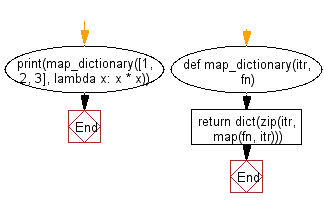Python: Map the values of a list to a dictionary using a function
Map List to Dictionary
Write a Python program to map the values of a list to a dictionary using a function, where the key-value pairs consist of the original value as the key and the result of the function as the value.
- Use map() to apply fn to each value of the list.
- Use zip() to pair original values to the values produced by fn.
- Use dict() to return an appropriate dictionary.
Sample Solution:
Python Code:
# Define a function called 'map_dictionary' that takes an iterable 'itr' and a function 'fn' as arguments.
def map_dictionary(itr, fn):
# Create a dictionary by zipping the iterable 'itr' and the result of applying the function 'fn' to each element in 'itr'.
return dict(zip(itr, map(fn, itr)))
# Example usage: Use the 'map_dictionary' function to create a dictionary where the keys are elements from the list [1, 2, 3] and the values are the squares of those elements.
print(map_dictionary([1, 2, 3], lambda x: x * x))
Sample Output:
{1: 1, 2: 4, 3: 9}
Flowchart:

For more Practice: Solve these Related Problems:
- Write a Python program to map a list of strings to a dictionary where each string is paired with its length.
- Write a Python program to map a list of numbers to a dictionary where each key is a number and the value is its square.
- Write a Python program to map a list of tuples to a dictionary using the first element as the key and the second as the value.
- Write a Python program to map elements of a list to a dictionary where keys are the original values and values are the result of applying a lambda function to each element.
Go to:
Previous: Write a Python program to build a list, using an iterator function and an initial seed value.
Next: Write a Python program to randomize the order of the values of an list, returning a new list.
Python Code Editor:
What is the difficulty level of this exercise?
Test your Programming skills with w3resource's quiz.
